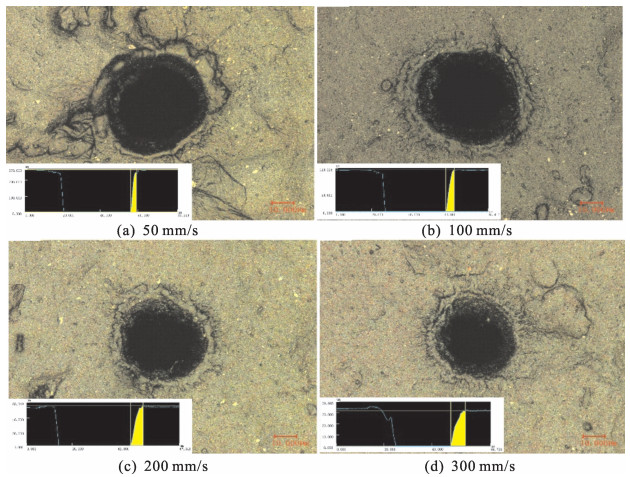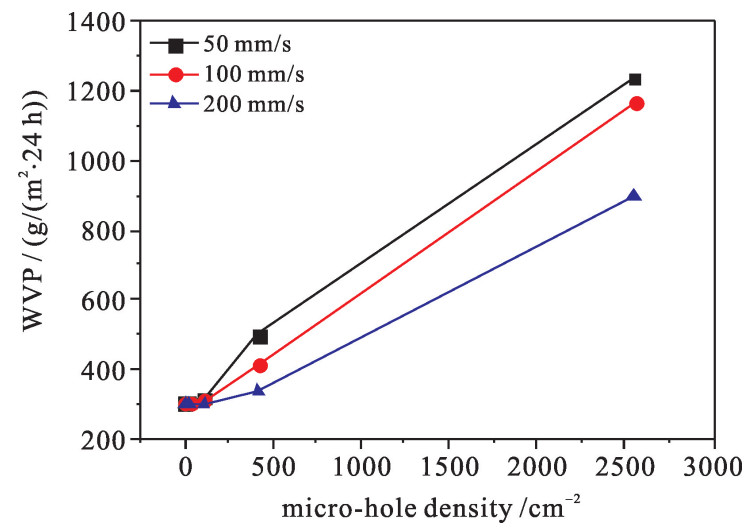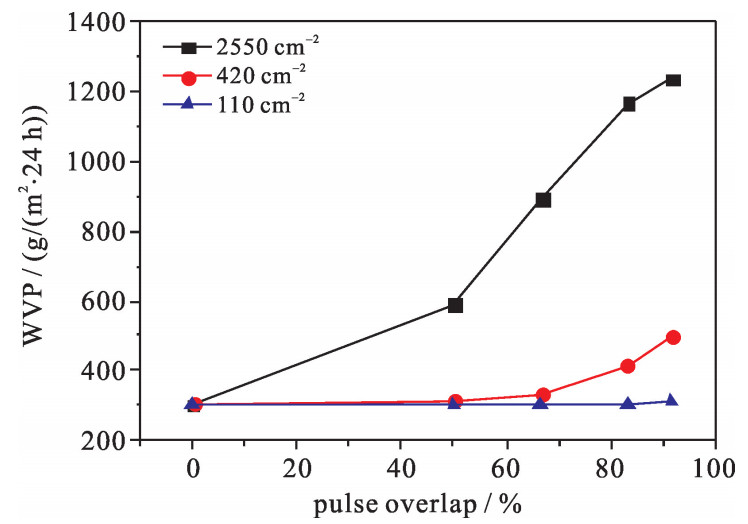Improving water vapor permeability of polyurethane synthetic leather by drilling micro-hole arrays with 343 nm femtosecond laser
-
摘要: 为了提高聚氨酯(PU)合成革透湿性,分别使用343 nm飞秒激光和作为对比的1030 nm飞秒激光及1064 nm纳秒激光制备微孔阵列。采用扫描电镜(SEM)和3D激光扫描显微镜对比研究了微孔形貌。结果表明,343 nm飞秒激光可以制备出效果最佳的微孔。此外,分析了3种激光与PU涂层的作用机理,揭示了343 nm飞秒激光合成革微钻孔过程仅表现为光化学烧蚀,光化学和光热烧蚀同时发生于1030 nm飞秒激光钻孔过程,而1064 nm纳秒激光只显示了光热烧蚀。激光合成革表面钻孔后,测量其透湿性和抗张力。结果显示: 微孔密度越大,皮革透湿性(WVP)越大而抗张力越低,脉冲重叠的增加会导致WVP的增加和抗张力的下降;同时,随着脉冲重叠从91.7%降到50%,微孔直径从45 μm降低到30 μm,而微孔锥度从0.7°增加到12.1°;当脉冲重叠率为91.7%,微孔密度为2550/cm2时,最大的WVP增长率为306%。Abstract: In this paper, 343 nm femtosecond laser and as a comparison, 1030 nm femtosecond and 1064 nm nanosecond lasers were used for improving water vapor permeability (WVP) of polyurethane (PU) synthetic leather. The morphologies of micro-hole were comparatively studied via a scanning electron microscope (SEM) and a 3D laser scanning microscope. The results indicated that 343 nm femtosecond laser was optimal to obtain excellent and small drilled micro through-holes. Moreover, analysis of interaction mechanism between laser beam and PU film revealed that the micro-drilling by 343 nm femtosecond laser exhibited photochemical ablation only, micro-drilling by 1030 nm femtosecond laser caused both photochemical and photothermal ablation, while micro-holes drilled by 1064 nm nanosecond laser resulted in photothermal ablation. By measuring the WVP and tensile resistance of the laser-drilled leather, it was concluded that the higher micro-hole density, the higher WVP value and lower tensile resistance, and the increase of pulse overlap led to an increase of WVP and a decrease of tensile resistance. The diameter of micro-hole decreased from 45 μm to 30 μm and taper of micro-hole increased from 0.7° to 12.1° with pulse overlap decreased from 91.7% to 50%. And, the highest WVP growth ratio was 306% at 2550 per sq. cm and the pulse overlap was 91.7%.
-
表 1 激光器的详细参数
Table 1. Specification parameters of lasers
laser average power/W wavelength/nm pulse duration frequency/kHz focal spot diameter/μm beam quality YDFLP-20-LP1-S >20 1064 200 ns 1~400 45 < 1.3 S-Pulse HP2 >8 1030 < 500 fs 1~300 38 < 1.3 S-Pulse HP2 < 1 343 < 500 fs 1~300 12 < 1.3 表 2 PU合成革激光打孔参数
Table 2. Laser-drilled parameters of PU synthetic leather
micro-hole spacing/mm micro-hole density/cm-2 scan velocity/(mm·s-1) 50 100 0.2 2550 200 300 50 100 200 0.5 420 300 50 100 1 110 200 300 2 30 50 100 200 300 -
[1] Sundar S, Vijayalakshmi N, Gupta S, et al. Aqueous dispersions of polyurethane-polyvinyl pyridine cationomers and their application as binder in base coat for leather finishing[J]. Progress in Organic Coating, 2006, 56(2): 178-184. [2] Chen Yi, Fan Haojun, Liu Ruowang, et al. Nano-SiO2 in-situ hybrid polyurethane leather coating with enhanced breathability[J]. Fibers and Polymers, 2010, 11(2): 241-248. doi: 10.1007/s12221-010-0241-3 [3] Qiang Taotao, Wang Xuechuan, Ren Longfang. Synthesis of hyperbranched polymers and its effect on water vapor permeability of microfiber synthetic leather[J]. Journal of Donghua University, 2010, 27(4): 463-468. [4] Gavgani J, Adelni H, Gudarzi M. Intumescent flame retardant polyurethane/reduced graphene oxide composites with improved mechanical, thermal, and barrier properties[J]. Journal of Material Science, 2014, 49(1): 243-254. doi: 10.1007/s10853-013-7698-6 [5] Yang Jie, Weng Wenguo, Fu Ming. Coupling of a thermal sweating manikin and a thermal model for simulating human thermal response[J]. Procedia Engineering, 2014, 84: 893-897. [6] Ghali K, Ghaddar N, Jones B. Modeling heat and moisture transport by periodic ventilation of thin cotton fibrous media[J]. International Journal of Heat and Mass Transfer, 2002, 45(18): 3703-3714. [7] Wu Y, Wang A, Zheng R, et al. Laser-drilled micro-hole arrays on polyurethane synthetic leather for improvement of water vapor permeability[J]. Applied Surface Science, 2014, 305(7): 1-8. [8] 贺璇, 王贺玲, 孙向浩, 等. 透湿超纤合成革制备及其性能研究[J]. 中国皮革, 2011, 40(21): 33-40. https://www.cnki.com.cn/Article/CJFDTOTAL-ZGPG201121010.htmHe Xuan, Wang Heling, Sun Xianghao, et al. Preparation and properties of moisture-permeable micro-fiber synthetic leather. China Leather, 2011, 40(21): 33-40 https://www.cnki.com.cn/Article/CJFDTOTAL-ZGPG201121010.htm [9] 曹婉鑫, 陈洋, 唐瑶, 等. 纳米TiO2/聚氨酯复合材料的制备及皮革涂饰剂应用[J]. 西部皮革, 2015, 37(4): 14-17. doi: 10.3969/j.issn.1671-1602.2015.04.006Cao Wanxin, Chen Yang, Tang Yao, et al. Preparation of nano-TiO2/polyurethane composite and its application in leather finishing. West Leather, 2015, 37(4): 14-17 doi: 10.3969/j.issn.1671-1602.2015.04.006 [10] Meng Qingbo, Lee S, Nah C, et al. Preparation of waterborne polyurethane using an amphiphilic diol for breathable waterproof textile coatings[J]. Progress in Organic Coatings, 2009, 66(4): 382-386. doi: 10.1016/j.porgcoat.2009.08.016 [11] Mondal S, Hu J. Water vapor permeability of cotton fabrics coated with shape memory polyurethane[J]. Carbohydrate Polymers, 2007, 67(3): 282-287. doi: 10.1016/j.carbpol.2006.05.030 [12] 宋斌, 钱晓明, 严姣. 超细纤维合成革透湿透气性能的研究进展[J]. 合成纤维工业, 2014, 37(4): 50-53. doi: 10.3969/j.issn.1001-0041.2014.04.013Song Bin, Qian Xiaoming, Yan Jiao. Research progress in water vapor permeability of microfiber synthetic leather. China Synthetic Fiber Industry, 2014, 37(4): 50-53 doi: 10.3969/j.issn.1001-0041.2014.04.013 [13] 何飞, 程亚. 飞秒激光微加工: 激光精密加工领域的前沿[J]. 中国激光, 2007, 34(5): 595-622. doi: 10.3321/j.issn:0258-7025.2007.05.001He Fei, Cheng Ya. Femtosecond laser micromachining: Frontier in laser precision micromachining. Chinese Journal of Lasers, 2007, 34(5): 595-622 doi: 10.3321/j.issn:0258-7025.2007.05.001 [14] 谢丰豪, 王文炎, 王爱华, 等. 激光微孔技术在制备多孔聚氨酯方面的应用[J]. 应用激光, 2013, 33(6): 618-622. https://www.cnki.com.cn/Article/CJFDTOTAL-YYJG201306010.htmXie Fenghao, Wang Wenyan, Wang Aihua, et al. Application of laser punching micropores in polyurethane. Applied Laser, 2013, 33(6): 618-622 https://www.cnki.com.cn/Article/CJFDTOTAL-YYJG201306010.htm [15] Han Zhidong, Fina A. Thermal conductivity of carbon nanotubes and their polymer nanocomposites: A review[J]. Progress in Polymer Science, 2011, 36(7): 914-944. doi: 10.1016/j.progpolymsci.2010.11.004 [16] 夏博, 姜澜, 王素梅, 等. 飞秒激光微孔加工[J]. 中国激光, 2013, 40(2): 1-12. https://www.cnki.com.cn/Article/CJFDTOTAL-JJZZ201302002.htmXia Bo, Jiang Lan, Wang Sumei, et al. Femtosecond laser drilling of micro-holes. Chinese Journal of Lasers, 2013, 40(2): 1-12 https://www.cnki.com.cn/Article/CJFDTOTAL-JJZZ201302002.htm [17] Oliveira R, Costa R, Sousa W, et al. Influence of genotype on physico-mechanical characteristics of goat and sheep leather[J]. Small Ruminant Research, 2007, 73(1/3): 181-185. [18] Garrison B, Srinivasan R. Laser ablation of organic polymers: Microscopic models for photochemical and thermal processes[J]. Journal of Applied Physics, 1985, 57(8): 2909-2913. [19] Kumagai H, Midorikawa K, Toyoda K, et al. Ablation of polymer films by a femtosecond high-peak-power Ti: sapphire laser at 798 nm[J]. Applied Physics Letters, 1994, 65(14): 1849-1852. [20] Rashvand M, Ranjbar Z, Rastegar S. Nano zinc oxide as UV-stabilizer for aromatic polyurethane coatings[J]. Progress in Organic Coatings, 2011, 71(4): 362-368. [21] Seet H, Tan L, Hong M, et al. Laser-drilled PVC template for electrodeposition of multi-core orthogonal fluxgate sensing element[J]. Journal of Materials Processing Technology, 2009, 209(9): 4429-4433. [22] Toubal L, Karama M, Lorrain B, et al. Stress concentration in a circular hole in composite plate[J]. Composite Structures, 2005, 68(1): 31-36. -





 下载:
下载:








